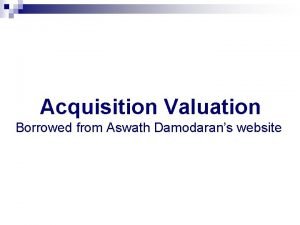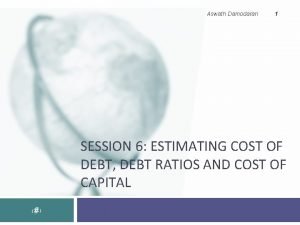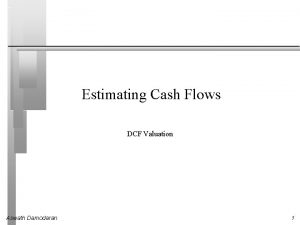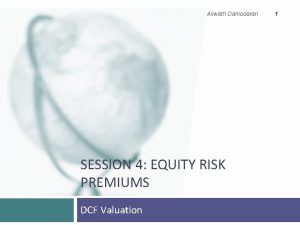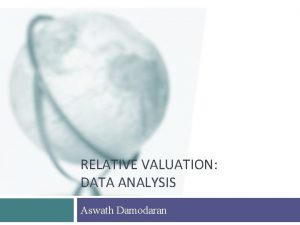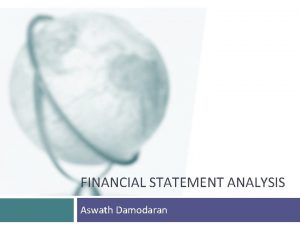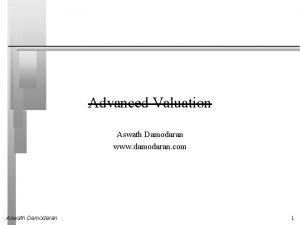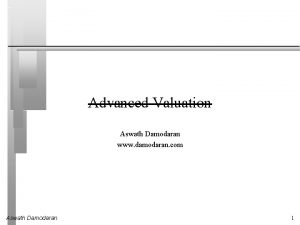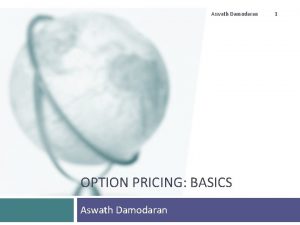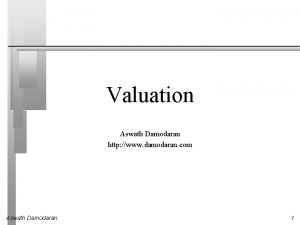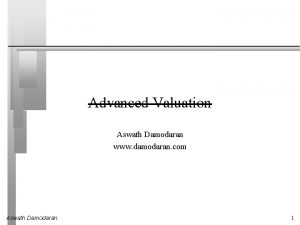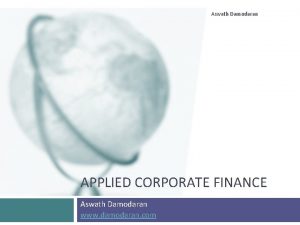Aswath Damodaran 1 SESSION 19 A PRIVATE COMPANY














- Slides: 14

Aswath Damodaran 1 SESSION 19 A: PRIVATE COMPANY VALUATION Aswath Damodaran

Key issues in valuing private businesses 2 No market value: In discounted cash flow valuation, we are often dependent upon market value for inputs (weights in the cost of capital), for risk measures (beta) and for output (to compare estimated value to a the end). Accounting issues: Small, private business accounting standards can often vary, with An intermingling of personal and business expenses A failure to separate salary from dividends Aswath Damodaran 2

Private company valuations: Motive Matters 3 Private to private transactions: You can value a private business for sale by one individual to another. Private to VC to Public: You can value a private firm that is expected to raise venture capital along the way on its path to going public. Private to public transactions: You can value a private firm for sale to a publicly traded firm. Private to IPO: You can value a private firm for an initial public offering. Aswath Damodaran 3

I. Private to Private transaction 4 In private to private transactions, a private business is sold by one individual to another. There are three key issues that we need to confront in such transactions: Neither the buyer nor the seller is diversified. Consequently, risk and return models that focus on just the risk that cannot be diversified away will seriously under estimate the discount rates. The investment is illiquid. Consequently, the buyer of the business will have to factor in an “illiquidity discount” to estimate the value of the business. Key person value: There may be a significant personal component to the value. In other words, the revenues and operating profit of the business reflect not just the potential of the business but the presence of the current owner. Aswath Damodaran 4

A. Estimating discount rates 5 Aswath Damodaran 5

Estimating a total beta 6 To get from the market beta to the total beta, we need a measure of how much of the risk in the firm comes from the market and how much is firm-specific. For instance, to compute the total beta for a privately owned retail business (high end), you would look at publicly traded high end retailers and look up two numbers: The average “unlevered” beta for high end retailers is 1. 18 The average correlation of high end retailers with the market is 0. 50. (This should be available in the same regression that yields the beta) Total Unlevered Beta = Market Beta/ Correlation with the market = 1. 18 / 0. 5 = 2. 36 Aswath Damodaran 6

Estimate a Debt to equity ratio, cost of equity & cost of capital 7 We will assume that this privately owned retailer will have a debt to equity ratio (14. 33%) similar to the average publicly traded retailers: Levered beta = 2. 36 (1 + (1 -. 4) (. 1433)) = 2. 56 Cost of equity =4. 25% + 2. 56 (4%) = 14. 50% (T Bond rate was 4. 25% at the time; 4% is the equity risk premium) To compute the cost of capital, we will use the same industry average debt ratio that we used to lever the betas. Cost of capital = 14. 50% (100/114. 33) + 4. 50% (14. 33/114. 33) = 13. 25% (The debt to equity ratio is 14. 33%; the cost of capital is based on the debt to capital ratio) Aswath Damodaran 7

B. Assess the impact of the “key” person 8 When a private business is dependent upon a “key person”, usually the owner/operator, a potential buyer will have to incorporate the effect of that key person leaving on value. The easiest way to incorporate the effect of a key person is to compute the operating income that the business would have without the key person involved and value it with that income. The current owner will therefore get a higher value for his or her business, if he or she agrees to stay on for a period, to ease the transition. Aswath Damodaran 8

C. Consider the effect of illiquidity 9 In private company valuation, illiquidity is a constant theme. All the talk, though, seems to lead to a rule of thumb. The illiquidity discount for a private firm is between 20 -30% and does not vary across private firms. But illiquidity should vary across: Companies: Healthier and larger companies, with more liquid assets, should have smaller discounts than money-losing smaller businesses with more illiquid assets. Time: Liquidity is worth more when the economy is doing badly and credit is tough to come by than when markets are booming. Buyers: Liquidity is worth more to buyers who have shorter time horizons and greater cash needs than for longer term investors who don’t need the cash and are willing to hold the investment. Aswath Damodaran 9

Ways of incorporating illiquidity into private company value 10 Reduce your estimated value by an illiquidity discount, with that discount either being a Fixed percentage of value for all businesses A variable percentage of value, as a function of the size, health and specific characteristics of the business being valued. Increase your discount rate to reflect illiquidity, with the increase either being An arbitrary number that you apply for all illiquid company A number that you can tie to a measure of how illiquid your company is. Aswath Damodaran 10

II. Private company sold to publicly traded company 11 The key difference between this scenario and the previous scenario is that the seller of the business is not diversified but the buyer is (or at least the investors in the buyer are). Consequently, they can look at the same firm and see very different amounts of risk in the business with the seller seeing more risk than the buyer. The cash flows may also be affected by the fact that the tax rates for publicly traded companies can diverge from those of private owners. Finally, there should be no illiquidity discount to a public buyer, since investors in the buyer can sell their holdings in a market. Aswath Damodaran 11

III. Private company for initial public offering 12 In an initial public offering, the private business is opened up to investors who clearly are diversified (or at least have the option to be diversified). There are control implications as well. When a private firm goes public, it opens itself up to monitoring by investors, analysts and market. The reporting and information disclosure requirements shift to reflect a publicly traded firm. Aswath Damodaran 12

The twists in an initial public offering 13 Valuation issues: Use of the proceeds from the offering: The proceeds from the offering can be held as cash by the firm to cover future investment needs, paid to existing equity investors who want to cash out or used to pay down debt. Warrants/ Special deals with prior equity investors: If venture capitalists and other equity investors from earlier iterations of fund raising have rights to buy or sell their equity at pre-specified prices, it can affect the value per share offered to the public. Pricing issues: Institutional set-up: Most IPOs are backed by investment banking guarantees on the price, which can affect how they are priced. Follow-up offerings: The proportion of equity being offered at initial offering and subsequent offering plans can affect pricing. Aswath Damodaran 13

IV. An Intermediate Problem Private to VC to Public offering… 14 When a venture capitalist is asked to invest in a private business, you fall somewhere between the two extremes in terms of the buyer being diversified. A venture capitalist is usually sector focused and not as diversified as the typical institutional investor in the market but is more diversified that the typical private business owner. Consequently, the beta for a VC will fall between the total beta (private business) and the market beta (diversified investor), yielding a cost of equity that lies between the two numbers. Following through, if you are valuing a small private business that you expect to transition through being held by a VC and then to being a public company, your cost of equity will change over the forecasted time period, going from a total beta cost of equity in the early years (when the owner is the sole investor) to a lower VC cost of equity in the intermediate years (when the VC is the marginal investor) to a market beta cost of equity (when the company goes public). Aswath Damodaran 14
 Damodaran private company valuation
Damodaran private company valuation Damodarans
Damodarans Interest coverage ratio damodaran
Interest coverage ratio damodaran Damodaran
Damodaran Aswath damodaran intrinsic value
Aswath damodaran intrinsic value Non cash working capital dcf
Non cash working capital dcf Aswath damodaran multiples
Aswath damodaran multiples Damodaran erp
Damodaran erp Aswath damodaran data
Aswath damodaran data Damodaran portfolio
Damodaran portfolio Which items are miscategorized balance sheet
Which items are miscategorized balance sheet Contrarian value investing
Contrarian value investing Damodaran multiples
Damodaran multiples Aswath damodaran discount rate
Aswath damodaran discount rate Aswath damodaran intrinsic value
Aswath damodaran intrinsic value

